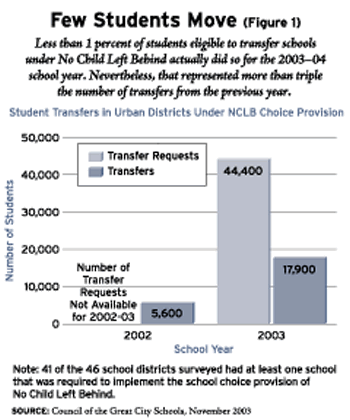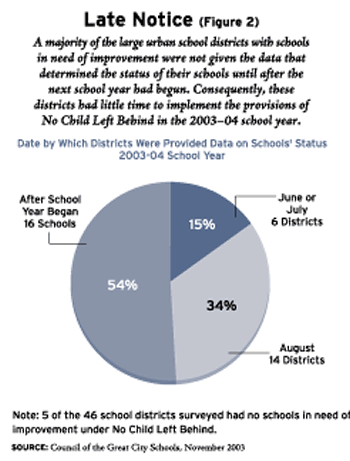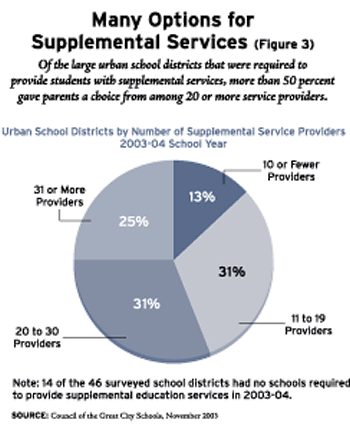
The leadership of America’s large urban school systems supported the No Child Left Behind Act (NCLB) as the legislation was heading to the House and Senate floors because of its intent to improve performance and close achievement gaps. But at the same time city leaders were wary, for the bill contained something seldom seen in federal education law: sanctions. Public schools that did not make “adequate yearly progress” faced an escalating set of consequences.
For starters, students in schools with two consecutive years of inadequate gains in their test scores must be offered the opportunity to transfer to another public school. After three consecutive years of inadequate gains, schools must also provide their students with “supplemental services,” such as after-school tutoring. Two later stages of sanctions, “corrective action” and “restructuring,” apply to schools that have not made adequate progress for several consecutive years. At these stages, the consequences can range from firing staff to closing down the school.
These accountability measures are intended to spur higher academic performance and to provide children in underperforming schools with better opportunities. The measures are also punitive in the sense that schools and school districts face both additional administrative burdens and increased expenses if they do not make sufficient progress.
Local school districts are two years into the implementation of the law, enough time to start asking how they are doing. To investigate their progress, the Council of the Great City Schools conducted a survey of its 60 member urban school districts and requested data on two of the measure’s accountability provisions: choice and supplemental services. Results from the 46 districts that responded as of November 2003 suggest that urban districts are implementing the requirements in these two areas, but are confronting a number of challenges as they do so.
Varying Results
During the 2003-04 school year, 498 schools in the 46 cities that participated in the survey were required to offer their students the opportunity to switch to a higher-performing school because of two consecutive years of inadequate progress. Another 510 schools were required to provide their students with supplemental services. Finally, 471 schools were identified for corrective action and 215 for restructuring. Altogether, schools that were at one of the various stages of school improvement composed 21 percent of all schools and about a third of all Title I schools in these cities. Among these 46 cities, eight cities were in “district improvement” status because their schools had not made satisfactory progress systemwide.
The number of schools in various stages of school improvement varied dramatically from city to city. For instance, Philadelphia has 194 of its public schools, about 74 percent, in one stage of sanctions or another. Likewise, more than half the schools in Chicago and Buffalo are in various stages of the school improvement process. By contrast, cities like Austin and Dallas have no schools being sanctioned.
For the most part, these disparities do not reflect genuine differences in student learning. For example, schoolchildren in Boston and San Diego perform similarly on the National Assessment of Educational Progress, yet 31 percent of Boston’s schools are in the improvement process, compared with just 18 percent of San Diego’s. Instead, the disparities are the result of Congress’s decision to let the states define their own standards of performance.
Public School Choice
The choice provision of No Child Left Behind is proving to be one of the most difficult parts of the law for urban schools to implement. Participation rates are low, though increasing somewhat. Some 1.2 million students in these cities were eligible to transfer to another public school during the 2003-04 school year; 44,000 requested a transfer; and 17,900 actually moved (see Figure 1). Nonetheless, this was more than triple the number of transfers from the previous year.

City officials, community groups, and others suggest a variety of reasons why the number of transfers has been low so far. Some parents do not want their children taking lengthy bus trips or riding public transportation. Some parents prefer having their children close to home. Some received information about their children’s eligibility and options too late to make a good decision. Some parents may not have gotten their first choice of school. Some do not consider the available options any better than their current situations. And some are frustrated by complicated application procedures. No one factor appears to explain the lack of movement.
The main method of communicating with parents was through the mail; all 41 districts that were required to offer transfers sent letters to parents informing them of their options. Twenty-two districts supplemented the mail with website information, newsletters, flyers, phone calls, parent and community meetings, advertisements, or media announcements.
New York City was particularly aggressive with its efforts. The school system posted first-class mail and placed automated telephone calls in ten languages; sent flyers home in backpacks; convened regional information sessions; sought help from some 20 community-based organizations; provided materials at local PTA meetings; established a chancellor’s hotline; set up a special website; and placed ads in community newspapers. These extra measures are important, since the high mobility rates in urban districts make it difficult to reach parents through mail alone. Still, there were parents and groups in New York and other cities who indicated that they did not get the information or that insufficient notification was provided. It is likely that some parents were missed.
One of the difficulties with informing parents was that none of the cities knew how many of their schools would be deemed “in need of improvement” before the end of the previous school year. For the 2003-04 school year, of the 46 districts, 14 did not receive their final test-score data from the state until August. Another 21 did not receive their data until after the new school year had begun (see Figure 2).

In the end, only nine districts were able to inform parents of their options before the end of the previous school year. All of these districts already had a districtwide open enrollment or “controlled choice” plan in place and were able to make an educated guess as to which students were likely to be eligible for a transfer under NCLB. Seven districts could not inform parents of their options until August, while 14 notified parents after the beginning of the 2003-04 school year.
School Capacity and Choice
All but two of the responding districts gave parents more than one choice of schools. The norm was to grant parents two or three options. New York City, however, offers eight choices, while Philadelphia, Jacksonville, Florida, Columbus, Ohio, and Nashville, Tennessee, offer six choices each.
Because demand was low, most districts were able to accommodate all or most of the students requesting transfers. For instance, the Miami-Dade County school district was able to accommodate all 321 of its transfer requests. New York City, with 8,000 requests, permitted every student to transfer.
Cities experiencing the most difficulty tend to lack the physical capacity to accommodate those transfers, have large numbers of schools identified for improvement, and have small numbers of schools eligible to receive students.
Take Philadelphia. The district itself has been deemed “in need of improvement.” Of its 261 schools, 34 are in Level I school improvement and 160 are in corrective action; together, these schools enroll some 100,000 eligible students. The district was able to locate just 1,240 open seats in 20 higher-performing schools that were eligible to receive students. And all of the surrounding districts rejected Philadelphia’s requests for seats, a situation that was mirrored, as far as I know, in all the other cities.
As it turned out, there were only 1,000 requests for transfers. But if in the coming years the number of requests grows substantially, the district may have little room for them. Philadelphia is discussing options to send students to parochial schools, but these schools also appear to have limited space, some private school parents are balking, and legal barriers remain.
It appears that the choice provisions are also causing some problems for the receiving schools. Most of the difficulty appears to relate to overcrowding and increased class sizes. The Portland, Oregon, schools, for instance, saw the average class sizes in high schools from which students were transferred dip to 22 students, while class sizes in receiving schools increased to 30. Class sizes in some receiving middle schools in New York City jumped to more than 40, a number that could have a dampening effect on student achievement.
We have seen little evidence, to date, that strategies proposed by the U.S. Department of Education, including creating schools within schools, delivering services through virtual schools, and housing students in mobile classroom units, are creating enough space to overcome capacity problems. These strategies are often too small-scale (virtual schools) or too expensive (mobile classrooms) to absorb the large numbers of students who are eligible to transfer.
Supplemental Services
The law also requires districts to offer tutorial services to students enrolled in schools that have failed to make adequate yearly progress for at least three years. To obtain these services, parents can select a public or private provider from a list of state-approved providers. School districts are then required to contract with the providers to deliver services.
So far, urban districts are providing Title I supplemental services to considerably more students than are taking advantage of the choice options. Of the 46 districts, 32 have at least one school that is required to offer supplemental services under NCLB. These districts indicated that they expected to serve some 134,000 students this school year in a supplemental service program.
Students may be participating in supplemental services in greater numbers than in choice programs because of the educational nature of the services, the ability to provide services on school property, and the latitude of school districts to provide their own services.
The number of state-approved providers in any one city ranges from as few as six in Greenville, South Carolina, to as many as 59 in New York City. Only four cities-Albuquerque, Boston, Greenville, and Portland-have ten or fewer state-approved providers. The average city has approximately 24 state-approved providers (see Figure 3).

This ratio suggests that there may be a glut of providers in some locales. For instance, Cleveland has 38 approved providers but only 15 schools in Level II school improvement or corrective action. Buffalo has 43 providers, but just 22 schools required their services. The apparent oversupply of providers in some sites may spur competition, but it may also be contributing to the frustration the providers feel concerning the small numbers of students in their programs.
The types of providers vary widely from city to city. For instance, Cleveland’s list includes such large national tutorial services as Huntington Learning Centers, Kaplan K12 Learning Services, Sylvan Learning, and the Princeton Review. A number of small to mid-size out-of-town providers are also on the list, including Brainfuse Online, Academia.net, JRL Enterprises, Kumon Reading and Math Centers, Club Z, and Elluminate. And the list contains such smaller local providers as Village One Concepts, Wims Enterprises, Learning for All, and the Boys and Girls Clubs of Cleveland.
A review of providers in other cities shows that several publishers and curriculum developers, like Lightspan, Voyager, Plato, CompassLearning, and Mosaica, are also starting to appear on state lists of approved providers. Some companies and providers are specializing in a single content area, like reading, while others concentrate on particular grades or grade spans. Few colleges or universities or faith-based groups appear on any of the state lists. And only a few private school-management firms, like Edison Schools, are evident. Just 18 of the 46 school districts were approved to be their own supplemental services providers.
Contracts and Services
As school districts and potential providers attempt to hammer out contracts, they have found themselves tussling over a number of details, including the length of the contracts, per-pupil fees, billing and payment procedures, staff qualifications, union rules, and the like.
For instance, many providers would like to receive a portion of their fees before work begins, but the districts often prefer to pay as the work proceeds. The providers would like to charge the districts a flat fee for the number of students enrolled in the tutorial sessions, but the districts want to be charged only for the number of students who actually attend the instructional sessions. The providers would like to build transportation fees into their overhead charges, but the districts generally disallow these expenses because the law does not authorize them.
Conflicts have also arisen about educational aspects of the supplemental services. The providers sometimes would like to use their own assessment tools to evaluate their services, while the districts want to evaluate the providers using state or local assessments. The providers would like to retain the nature of their services as they were designed, while the districts want services to be aligned with district curricula. The providers want the right to reject students with disabilities or English language learners on the grounds that they require specialized services and facilities that they do not have. The districts would like the providers to serve all those who are eligible, including students with disabilities and English language learners.
The next major tasks that both the districts and providers must address are the alignment of supplemental services with the curriculum and the evaluation of providers’ effectiveness. Alignment issues are more acute with providers who come with prepackaged curricula or ready-to-use materials. Providers often have to attest that their programs are aligned with state standards, but it is hard to imagine that this is really the case, particularly for providers working in multiple states.
Many urban school districts are discovering that they make the greatest academic gains when they use a more cohesive, less splintered, and sometimes more prescriptive instructional program. Often these curricula come with assessments that are used by teachers to gauge the specific skills of individual students. Districts with the best instructional results often have very specific requirements or materials for their after-school interventions that may or may not be consistent with what the individual service providers are prepared to use.
The challenge is further complicated when the district uses a detailed pacing guide that specifies, often on a weekly basis, when specified skills are taught. These pacing guides are usually aligned with state tests in a way that ensures teachers teach the skills measured on the state test before the test is given, rather than after. Aligning service providers with this practice has not even started yet, but is likely to occur in the next year or two. The ability to get this process right will determine in large measure whether the supplemental services provision of the law spurs student achievement.
The districts also face evaluation and assessment challenges. The law requires states to develop ways to monitor approved providers and to withdraw approval from those that fail to help increase student learning. The law is ambiguous, however, about who is supposed to assess the providers and how the evaluations are to be conducted.
The vast majority of districts required to provide supplemental services are using only Title I funds to pay for these services and for choice programs. So far, most of the expense has been covered by the sizable increases in federal Title I funds districts have received over the past two years. For instance, Denver is setting aside $2.5 million for choice and another $1.7 million for supplemental services, or about 18.8 percent of its Title I allocation, but the total has absorbed the lion’s share of the district’s $5.5 million increase in Title I revenues in the first year of NCLB-leaving about $1.3 million or about $29.15 per student for overall program improvement.
In some districts, the poor economy wiped out any benefits from increases in Title I funds. For instance, the Buffalo school district had to cut about $37.5 million from its general budget in 2002-03, dwarfing the $10.5 million increase in Title I funding the district received between fiscal years 2001 and 2003. And the Oakland schools absorbed some $63 million in state and local cuts, an amount that overshadowed the $8.4 million increase the district saw in Title I funding.
Conclusion
It is still early in the implementation of No Child Left Behind to judge its choice and supplemental service provisions. Many cities are just getting started this year. But the preliminary data suggest that the programs are taking shape on the ground, even if the increases in the numbers of participating students are not as high as many would eventually like to see.
It is also clear that the law is experiencing growing pains. The implementation of choice and supplemental services is causing frustration among the urban school leaders who otherwise back NCLB. One hears very little carping among urban leaders about those NCLB components that are more directly linked, in their view, to student performance and accountability-the provisions for adequate yearly progress, testing, data disaggregation, report cards, and professional development. At this early stage of implementation, carrying out the requirements for choice and supplemental services is absorbing substantial amounts of time, expertise, and resources without a clear connection to what NCLB purports to be about-student performance. Many urban leaders see less energy being devoted at the federal and state levels to raising achievement than to implementing the law’s sanctions.
Nevertheless, urban school leaders tend to feel more positive toward this legislation than do many of their suburban and rural counterparts. This may owe to the fact that suburban and rural schools are less accustomed to having their test scores publicized and scrutinized than are urban schools. In the minds of many urban educators, the law remains the single most important piece of federal education legislation to emerge in a generation. Its goals of raising achievement, closing achievement gaps, and strengthening accountability are exactly what the best urban educators in the country have been working for. Eventually, No Child Left Behind and the paradigm shift it represents are likely to give the nation exactly what it wants urban schools to deliver-more choice and higher achievement. Once that happens, urban schools will have succeeded in meeting a challenge as ambitious as any nation has set for its schools. And they will have made their initial support for the law worth the effort.
Michael Casserly is executive director of the Washington, D.C.-based Council of the Great City Schools.


